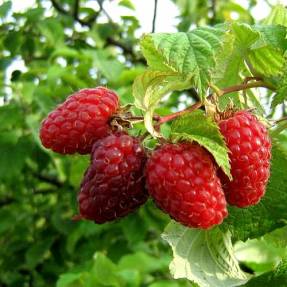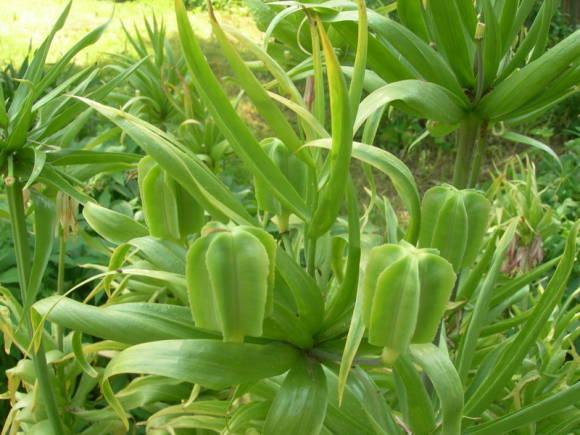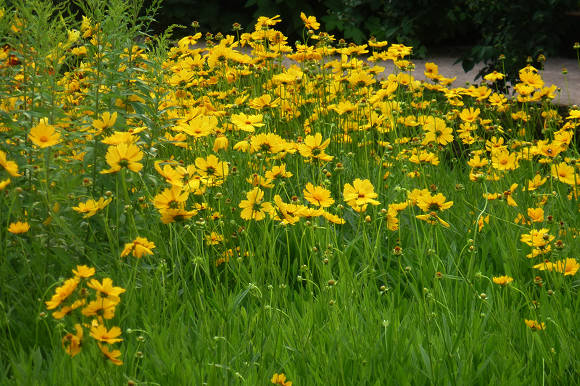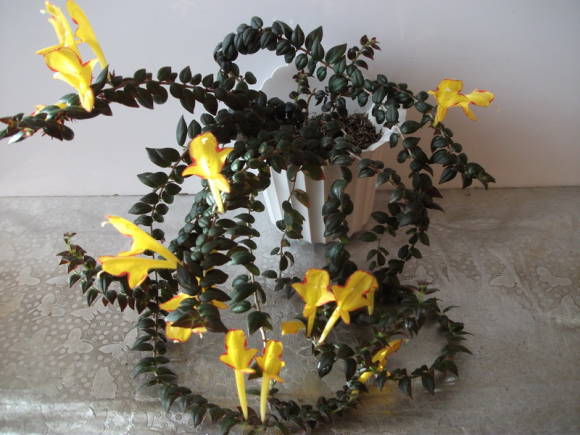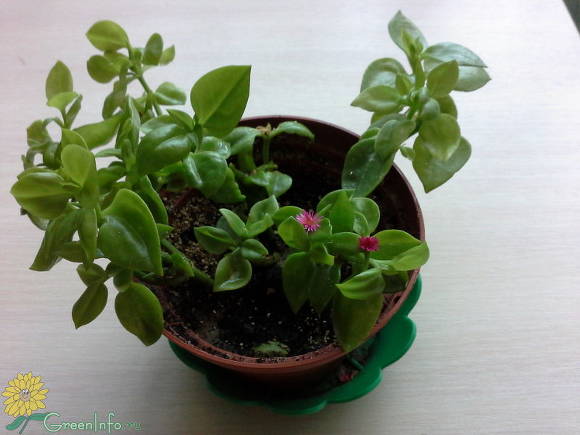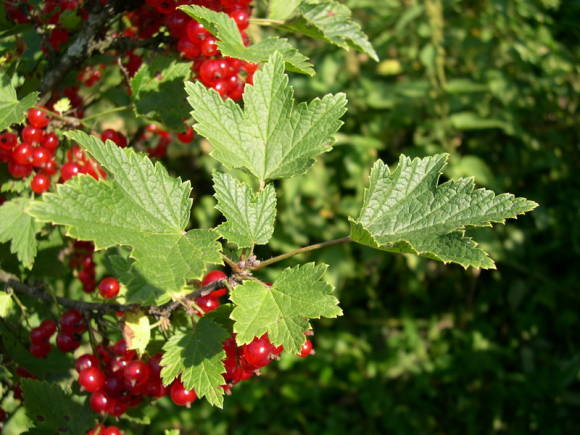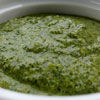 In recent years, it has become fashionable to decorate areas with bright figures of gnomes. There is no dispute about tastes, but is it not better to remove all this and ... plant mountain women, or "flowers of elves". Then, perhaps, the real keepers of your garden will settle in the openwork foliage of plants? And the joy that you feel when mountain women bloom under the treetops, I can’t even express it in words. Indeed, it is at this time that the plants look like something delicate, weightless, trembling from a light breeze. The soul is captured by a feeling of bliss and quiet joy. "Flower of the elves" - not without reason this plant is called in Germany, Holland and other countries of Western Europe, where it has taken root in amateur gardens. The British call the mountain women more prosaically - "the cap of the archbishop", because of the presence of a spur on the rim. Unfortunately, in our country, this plant has not yet been appreciated by amateur flower growers and is rarely found in plots.
In recent years, it has become fashionable to decorate areas with bright figures of gnomes. There is no dispute about tastes, but is it not better to remove all this and ... plant mountain women, or "flowers of elves". Then, perhaps, the real keepers of your garden will settle in the openwork foliage of plants? And the joy that you feel when mountain women bloom under the treetops, I can’t even express it in words. Indeed, it is at this time that the plants look like something delicate, weightless, trembling from a light breeze. The soul is captured by a feeling of bliss and quiet joy. "Flower of the elves" - not without reason this plant is called in Germany, Holland and other countries of Western Europe, where it has taken root in amateur gardens. The British call the mountain women more prosaically - "the cap of the archbishop", because of the presence of a spur on the rim. Unfortunately, in our country, this plant has not yet been appreciated by amateur flower growers and is rarely found in plots.
Genus mountain woman(Epimedium), belonging to the Barberry family, currently includes more than 50 species. And this is not the limit, since every year in the Sy-Chuan province, botanists find more and more new species. Interesting fact: Mountain goats are found exclusively in the Eastern Hemisphere, where they inhabit the foothills of Europe, the Caucasus, Turkey, Japan and China. Only one species has been found in Northwest Africa. In nature, goryanka grow in damp mountain forests or on mountain spurs (maybe that's why they are called in Russian - goryanka). Many species are found on limestones.
All mountain goats are herbaceous perennials with a highly branched rhizome, from which leaves extend on long, 15 to 50 cm stalks. The distance between the leaves determines the appearance of the plants. If it is 1-2 cm, dense "bushes" are formed, and if it is more, from 2 to 7 cm, "bushes" will be looser. The rhizome grows horizontally from the center to the periphery, and after 4-5 years old plants begin to die off the central part of the "bush", which reduces decorativeness. Therefore, in these terms, in order to preserve the decorative effect, the plants must be divided.
In some species, the leaves of mountain goats are winter-green, in others, they are renewed annually. Now, when many hybrids have appeared in culture, the leaves can be semi-wintergreen. Leaves are compound, double or triple pinnate. The leaves are located on thin petioles and have an oval, heart-shaped or arrow-shaped shape. The edge of the leaves can be smooth, finely toothed or wavy. The texture of the leaf is dense, leathery. In some mountain goats, the leaves along the edge and along the veins are painted in a bright purple or orange tone, which makes them very decorative.
The flowers of mountain goats are rather small: from 0.5 to 2 cm. They are unusual. The flower has eight sepals, they are arranged in two rows. Four outer small trough-shaped, fall off when the flower opens. The four inner ones are similar to petals, arranged crosswise. Corolla petals - there are also four of them, can be divided, or fused in the form of a ring.
The petals of different species differ in shape. They may have spurs, long or short, or they may not. The color of the flowers is different. It can be red, purple, yellow, white, or a combination of these colors. Flowers, collected in a simple or double-branched brush, depending on the length of the peduncles, float above the bushes, or look out of young leaves. For flowers of mountain goats, protogyny is characteristic (maturation of stigmas of pistils before pollen in stamens matures), therefore, if insect pollination has not occurred, the column of pistil begins to grow after pollen matures in stamens of the same flower. The column grows past the anthers, and pollen adheres to the stigma. This can be said to be a backup method of pollination, allowing you to set seeds in the absence of pollinators. The fruit of mountain goats is dry. Drop-down. Seeds with large appendages called aryllus. The seeds are spread by ants, which are attracted by nutrient-rich appendages.
In the gardens of Europe, the first mountain women, transplanted from the surrounding forests, appeared at the end of the 18th century. Chinese and Japanese species became known to Europeans later, only at the end of the 19th century. Now in the gardens of Russian flower growers there are already more than a dozen species and varieties of mountain goats. The most common ones are:
Alpine Horny Goat Weed(Epimediumalpinum) originally from Europe, 15-25 cm high. Forms loose sods. Flowers without spurs. The sepals are reddish, the petals are yellow.

Horny Goat Weed(Epimedium grandiflorum) grows on the islands of Japan. Forms dense sods 30-59 cm high. Its flowers with long spurs are very beautiful. Species plants have lilac flowers, but there are varieties "Lilacinum"(«Lilacinum ") and "Lilafeya"(«Lilafea ") with lilac color, Rose Queen(«Rose Queen ") with pink and "White Queen"(«White Queen ") with white flowers.

Korean Mountain Goat Weed(Epimediumkoreanum) found in the shady forests of the Far East. Forms loose sods up to 40 cm high. Leaves are non-wintering. The flowers are very beautifully shaped, large, with a spur, few in the raceme, white or pink.

Horny Goat Weed, or feathery(Epimediumcolchicum =Epimediumpinnatum). Originally from Turkey and the Caucasus, where it grows in dry shady forests. Forms rather dense turf up to 35-55 cm high. Evergreen leaves, flowers up to 1.5 cm, collected in a rare brush, small, yellow, without spurs.

Mountain girl Perralderi(\Epimediumperralderianum) originally from Algeria, where it grows at an altitude of 1200-1500 m above sea level in oak and cedar forests. Forms dense sods up to 30 cm high, with evergreen leaves. The leaves of this species of Horny Goat Weed are very decorative. Young ones are bronze in color, with aging they become dark green with distinct reticular veins. In addition, the leaf blades have a finely toothed, wavy edge. The flowers are collected in a sparse raceme, yellow with a brownish-red border along the edge, without spurs, rather large.
Horny Goat Weed(Epimediumpubigerum) originally from Bulgaria and Turkey. The leaves are evergreen, pubescent at a young age. The height of loose sods is up to 30 cm. The flowers are small, white-pink.

At present, due to the growing interest in these amazing plants in European countries, many hybrid mountain goats have appeared. The most famous are:
Mountain Goat Weed Cantabrian(Epimediumx cantabrigiense) was born as a result of crossing the downy and alpine fire. This is a hybrid with evergreen foliage, loose sod 30-60 cm high, with ceutonos towering above the leaves, usually blooms very profusely with small white-pink flowers.

Horny Goat Weed(Epimediumx rubrum) - a hybrid of the large-flowered and alpine mountain goat. Plants up to 40 cm high. Young leaves are very beautiful. They are purple along the edge and along the veins. Flowers up to 1.5 cm, red and yellow. This Horny Goat Weed is the most common in our gardens.

Horny Goat Weed(Epimediumx versicolor) - a hybrid of the Horny Goat Weed and Colchis. We know its variety sulfur yellow(E. x versicolor var. sulphureum) with yellow flowers up to 1.5 cm. Sod trees are quite dense, up to 40 cm high. Young foliage is colored.

Horny Goat Weed(Epimedium x warleyense) forms dense curtains with a height of 45-50 cm.Its variety is widespread in our gardens "Orange Kenigin"(«Orange Konigin ") with large up to 1.5 cm orange flowers, towering above evergreen foliage.

Mountain goats are unpretentious plants. They endure both full lighting and full shade, they are demanding on soils. However, they bloom best in partial shade on humus soils with neutral acidity. They should be planted at a distance of 35-40 cm from each other. Some sources indicate that there are mountain women belonging to the fifth or even warmer zone. However, practice has shown that they successfully grow and develop if you know the peculiarities of their cultivation: before winter, in all species, it is necessary to mulch the root system with compost, and mountain goats of Chinese and Japanese origin should be covered in addition to this. The evergreen foliage of mountain goats in the Moscow region loses their decorative effect, therefore, in the spring, overwintered leaves should be cut to the level of the soil. It is difficult to do this as soon as the snow melts, as mountain goats start growing very early. However, it must be remembered that spring frosts below 1-2 degrees can damage the delicate young foliage and flower buds. Therefore, it is safer not to rush to remove the shelter in the spring.
Mountain goats do not require intensive feeding.Mulching with compost before winter and one-time standard feeding in spring is quite enough for their normal development.
Pests and diseases rarely harm mountain goats. In the southern regions, they are damaged by grape weevils, and slugs can disfigure young foliage. Mice and voles sometimes gnaw shoots.
The life expectancy of mountain women is 10 years or more. They are unpretentious in culture, form spectacular, slowly or moderately growing clumps. Mountain women attract attention all season: in spring - with amazing delicate flowering, in summer and autumn - with beautiful ornamental foliage. Mountain women are good under trees and shrubs, in rockeries, at the base of a hill, or just in a mixborder between primroses, geyhers, lungwort, ferns. Combine with cereals and small-bulbous.
Tatiana Shapoval,member of the Moscow Flower Club
